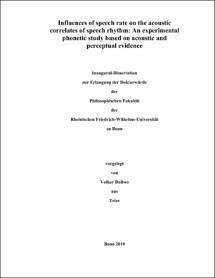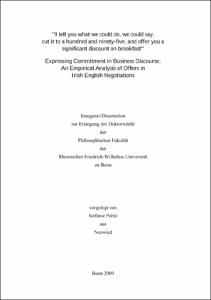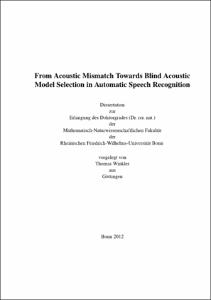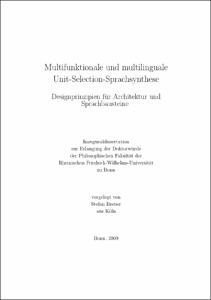Dellwo, Volker: Influences of speech rate on the acoustic correlates of speech rhythm : An experimental phonetic study based on acoustic and perceptual evidence. - Bonn, 2010. - Dissertation, Rheinische Friedrich-Wilhelms-Universität Bonn.
Online-Ausgabe in bonndoc: https://nbn-resolving.org/urn:nbn:de:hbz:5-20033
Online-Ausgabe in bonndoc: https://nbn-resolving.org/urn:nbn:de:hbz:5-20033
@phdthesis{handle:20.500.11811/4239,
urn: https://nbn-resolving.org/urn:nbn:de:hbz:5-20033,
author = {{Volker Dellwo}},
title = {Influences of speech rate on the acoustic correlates of speech rhythm : An experimental phonetic study based on acoustic and perceptual evidence},
school = {Rheinische Friedrich-Wilhelms-Universität Bonn},
year = 2010,
month = feb,
note = {Human listeners can distinguish languages of different rhythmic classes (rhythm class hypothesis) based on durational characteristics of consonantal and vocalic intervals (e.g. %V, deltaC, PVI). The present study investigated the influence of speech rate on measurements of speech rhythm and on the perception of rhythmic differences between languages. A database (BonnTempo-Corpus) was created comprising speech from 5 different languages (Czech, English, French, German, and Italian) that was characterised by high tempo variability within each language (very slow, slow, normal, fast and fastest possible speech). Results from the database revealed that measures of speech rate are equally reliable rhythm class indicators as measures of speech rhythm. As a consequence of this finding perception experiments were conducted to test to what extent listeners use rate as an indicator to rhythm class. In one experiment native listeners rated rhythmic regularity in delexicalized French and English sentences that varied in acoustically measurable rhythm and rate to natural degrees. Results revealed that rate correlated best with listeners’ perception of rhythmical events. In a second perceptual experiment listeners of English and French rated the pronunciation quality of speech in their native language produced by German native speakers. Results provided further evidence for rate measures being a correlate of pronunciation quality. No such evidence could be found for rhythm measures. Based on these findings a new theory was developed which claims that the auditory impression of languages falling into different rhythmic classes is to a high degree based on rate differences between these languages. To develop this argument it was further necessary to study the effects of speech rate on measurements of speech rhythm. It was demonstrated that some of the rhythm measures correlated negatively with speech rate (deltaC, rPVI). For this reason rate normalization methods for rhythmic measurements were either developed or refined. The study also includes two excursions, one in which the history of the rhythm class argument was studied and another one in which influences of linguistic/para-linguistic parameters on measurements of speech rhythm were analyzed.},
url = {https://hdl.handle.net/20.500.11811/4239}
}
urn: https://nbn-resolving.org/urn:nbn:de:hbz:5-20033,
author = {{Volker Dellwo}},
title = {Influences of speech rate on the acoustic correlates of speech rhythm : An experimental phonetic study based on acoustic and perceptual evidence},
school = {Rheinische Friedrich-Wilhelms-Universität Bonn},
year = 2010,
month = feb,
note = {Human listeners can distinguish languages of different rhythmic classes (rhythm class hypothesis) based on durational characteristics of consonantal and vocalic intervals (e.g. %V, deltaC, PVI). The present study investigated the influence of speech rate on measurements of speech rhythm and on the perception of rhythmic differences between languages. A database (BonnTempo-Corpus) was created comprising speech from 5 different languages (Czech, English, French, German, and Italian) that was characterised by high tempo variability within each language (very slow, slow, normal, fast and fastest possible speech). Results from the database revealed that measures of speech rate are equally reliable rhythm class indicators as measures of speech rhythm. As a consequence of this finding perception experiments were conducted to test to what extent listeners use rate as an indicator to rhythm class. In one experiment native listeners rated rhythmic regularity in delexicalized French and English sentences that varied in acoustically measurable rhythm and rate to natural degrees. Results revealed that rate correlated best with listeners’ perception of rhythmical events. In a second perceptual experiment listeners of English and French rated the pronunciation quality of speech in their native language produced by German native speakers. Results provided further evidence for rate measures being a correlate of pronunciation quality. No such evidence could be found for rhythm measures. Based on these findings a new theory was developed which claims that the auditory impression of languages falling into different rhythmic classes is to a high degree based on rate differences between these languages. To develop this argument it was further necessary to study the effects of speech rate on measurements of speech rhythm. It was demonstrated that some of the rhythm measures correlated negatively with speech rate (deltaC, rPVI). For this reason rate normalization methods for rhythmic measurements were either developed or refined. The study also includes two excursions, one in which the history of the rhythm class argument was studied and another one in which influences of linguistic/para-linguistic parameters on measurements of speech rhythm were analyzed.},
url = {https://hdl.handle.net/20.500.11811/4239}
}









